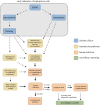Towards a leptospirosis early warning system in northeastern Argentina
- PMID: 37194269
- PMCID: PMC10189304
- DOI: 10.1098/rsif.2023.0069
Towards a leptospirosis early warning system in northeastern Argentina
Abstract
Leptospirosis is a zoonotic disease with a high burden in Latin America, including northeastern Argentina, where flooding events linked to El Niño are associated with leptospirosis outbreaks. The aim of this study was to evaluate the value of using hydrometeorological indicators to predict leptospirosis outbreaks in this region. We quantified the effects of El Niño, precipitation, and river height on leptospirosis risk in Santa Fe and Entre Ríos provinces between 2009 and 2020, using a Bayesian modelling framework. Based on several goodness of fit statistics, we selected candidate models using a long-lead El Niño 3.4 index and shorter lead local climate variables. We then tested predictive performance to detect leptospirosis outbreaks using a two-stage early warning approach. Three-month lagged Niño 3.4 index and one-month lagged precipitation and river height were positively associated with an increase in leptospirosis cases in both provinces. El Niño models correctly detected 89% of outbreaks, while short-lead local models gave similar detection rates with a lower number of false positives. Our results show that climatic events are strong drivers of leptospirosis incidence in northeastern Argentina. Therefore, a leptospirosis outbreak prediction tool driven by hydrometeorological indicators could form part of an early warning and response system in the region.
Keywords: Bayesian modelling; El Niño; climate; early warning system; leptospirosis; outbreak prediction.
Conflict of interest statement
The authors declare no conflicts of interest.
Figures





References
-
- PLoS ONE. 2022 Neglected tropical diseases. See https://journals.plos.org/plosone/browse/neglected_tropical_diseases (accessed 5 May 2023).
Publication types
MeSH terms
LinkOut - more resources
Full Text Sources
